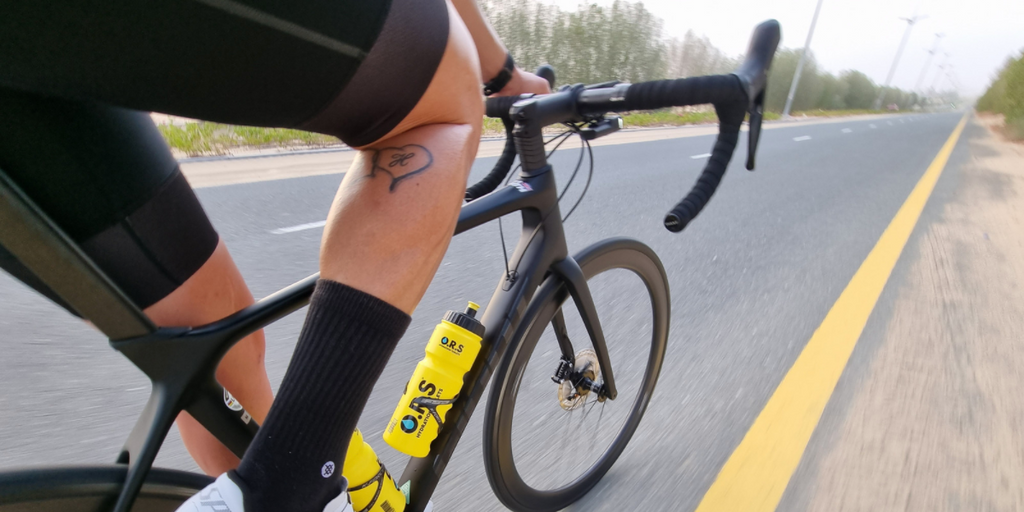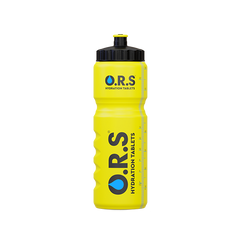Hydration For Cyclists

It’s a well-known fact that water is essential for our bodies to function. It enriches our blood and carries vital oxygen and nutrients to our muscles. It also has another job to perform: it removes waste products from our muscles too.
Any physical exercise, such as cycling, means that we end up expelling water from our bodies. This happens through the process that we know as perspiration. It’s a natural way of cooling our bodies when we are doing something physical.
As you can imagine, it is important to keep our bodies hydrated. When on cycling rides, we must replenish water and other essential nutrients at regular intervals.
WHAT HAPPENS IF WE DON’T STAY HYDRATED WHEN WE CYCLE?
Another fact that you might be aware of is that our bodies comprise of 60% water. There is plenty of research to prove that even small amounts of dehydration can affect our bodies. And that is especially the case for cyclists. For example, a 2% loss of body weight through perspiration equates to 1.6 kg for an 80 kg rider.
When that happens, they will experience a significant loss in performance. A 4% loss will lower your ability to perform muscular work. At 5%, you will start to get affected by heat exhaustion. You’ll also be approximately 30% less efficient on your bike.
Even worse still is when you lose 7% or more of your body weight through perspiration. You can expect to hallucinate for a start. And, as time goes one, your circulatory system will collapse.
That can cause things like heat stroke and even death, believe it or not. As you can imagine, it’s absolutely vital that you stay hydrated when you go out cycling.
WHAT ARE THE TELL TALE SIGNS OF DEHYDRATION?
When you first begin to perspire while cycling, you’ll notice that you’re not at your best. That’s because your performance is getting impaired by your physical activity. So far, we know how serious things can get if we become dehydrated for a long time.
But, what happens when we first start to dehydrate while cycling? As it turns out, dehydration starts to do a few different things to your body. They are as follows:
Lower volume of blood. A hydrated body is essential for regulating our blood volumes. As we cycle and perspire, those volumes drop. As a result, so does our blood pressure. That means our hearts start beating faster than usual. For some cyclists, this can also mean headaches and migraines getting triggered.
Lower skin blood flow. Because of the lower blood volume in the body, a “coping mechanism” occurs. What happens is our bodies will divert blood away from the skin and towards our vital organs. When that occurs, you will notice some visible changes in your skin. It will feel cold to the touch and sticky, and it will start to lose its elasticity.
Less sweating. You might think that not sweating so much during cycling is a good thing. But, it’s a sure-fire sign that your body is getting dehydrated. Your body needs to sweat for two reasons.
First of all, it helps to keep your skin hydrated during physical activity. And, second, it maintains your body’s electrolyte levels. Your body will tend to sweat more on long cycling journeys and those in hot climates.
Lower heat dissipation. When you’re cycling, it’s important for your body to keep cool as much as possible. The way it does that is by increasing your blood circulation. Your body brings that hot blood closer to the surface of your skin.
As you know, dehydration decreases your blood volume. When that happens, your body can’t easily cool you down while cycling. That’s because there isn’t much blood to go around!
Higher core temperature. It goes without saying that lower heat dissipation means you’ll feel hotter. The blood circulating in your body can’t cool down quick enough. That’s because it’s diverting more of it to your vital organs and less to your skin. As a result, you’ll have a higher core temperature.
Higher usage of muscle glycogen. Whenever we eat something, the glucose levels in our bodies rise. In a nutshell, glucose gets used to provide energy to our muscles. The storage areas for glucose in our bodies is called glycogen. When we do any physical activity, our bodies access glycogen storage areas more often.
If our bodies have low amounts of glycogen available for our muscles, we start to feel weak. It goes without saying that the effect becomes more profound when cycling.
Lower digestive functions. One way dehydration affects body performance is through low digestion function. An obvious telltale sign is little to no urination. Another is the increased risk of stomach ulcers.
That’s because your body cannot produce mucus to protect the membrane of your stomach. When that stops happening, acidic digestive fluid starts to destroy that membrane.
Fatigue and energy loss. One of the prominent symptoms of dehydration is that you’ll start feeling tired. You’ll feel lethargic and less likely to want to continue cycling.
HOW CAN WE STAY HYDRATED WHILE CYCLING?
You know what could happen to your body if you become dehydrated. You also know that it can cause a lot of issues the longer you don’t replenish any water lost from your body. But, do you know how you should stay hydrated?
As you can imagine, keeping your body hydrated in general is always a good idea. Hydration for cyclists is even more important, given that you expel water at a more rapid rate. The good news is that it is simple to keep your body hydrated. Here is what you need to know before and during cycling:
What to do before you start cycling
Keeping on top of your body’s hydration levels begins before you even get on the saddle! Contrary to popular belief, you don’t need to drink several litres of water before you go out cycling. If you maintain your hydration levels, you should be good to go!
Experts recommend that you drink at least two to three litres of water a day. It’s a good idea to avoid drinks that will make you urinate more. Examples include tea and coffee and sugary soft drinks. If you’re planning to go for a long cycling trip, ensure that you are healthy before you go.
For instance, if you’re suffering from diarrhoea, the condition will be dehydrating your body. It’s best to resolve such medical conditions before you do any long-term cycling. Otherwise, you will find you need to rehydrate yourself more often.
Another thing you should do before you cycle is to determine how much fluid you need to drink. One way to do so is by weighing yourself and then carrying out a sixty-minute sweat test. In other words, go and do something physical like cycling or running for an hour.
Next, dry yourself down when you get home and weigh yourself again. Make a note of the weight difference. This is roughly the amount of water you’ve lost from your body in millilitres. Most people tend to lose around 500 ml to one litre of water from their bodies per hour. Armed with this information, you now know how much fluid to drink per hour of cycling.
Keeping hydrated while you cycle on short journeys
It goes without saying that you should take some water with you when you cycle. Your bicycle provides an easy storage medium for large sports bottles.
Now that you know how much water your body loses when sweating, you can take plenty of water with you. Some cyclists wrongly assume that they should only drink when they feel thirsty. But, it’s important to go with the “little and often” approach.
What you should aim to do is take two to three gulps of water every ten or fifteen minutes. That way, your body will stay hydrated throughout the duration of your journey. The good thing about sports bottles is you can drink from them while you cycle. That means you don’t have to make any stops: perfect for cycling competitions!
Water alone is fine to drink if you’re cycling for 60 minutes or less per session.
If you’re going cycling for several hours, you need something other than water. That’s because you need to add electrolytes and carbohydrates to your body.
A solution to carrying around heavy food with you is to take some cycling hydration tablets. Two O.R.S. tablets, for example, will dissolve in 200 ml of water. They are an ideal way to keep your body energised and performing at its best.
O.R.S. cycling hydration tablets are available in three different flavours. You can get them in strawberry and lemon and blackcurrant. These electrolyte tablets are excellent hydration for cyclists before, during and after the ride. Now you can stay hydrated while having something great to drink!
You can use up to 20 O.R.S. cycling hydration tablets in a 24-hour period. So, if you’re planning an epic cycling trek, you can keep going for longer without the need to stop!

